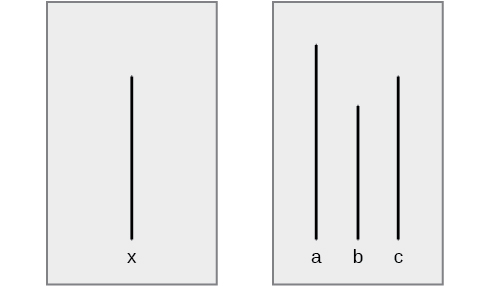| << Chapter < Page | Chapter >> Page > |
In this section, we discuss additional ways in which people influence others. The topics of conformity, social influence, obedience, and group processes demonstrate the power of the social situation to change our thoughts, feelings, and behaviors. We begin this section with a discussion of a famous social psychology experiment that demonstrated how susceptible humans are to outside social pressures.
Solomon Asch conducted several experiments in the 1950s to determine how people are affected by the thoughts and behaviors of other people. In one study, a group of participants was shown a series of printed line segments of different lengths: a, b, and c ( [link] ). Participants were then shown a fourth line segment: x. They were asked to identify which line segment from the first group (a, b, or c) most closely resembled the fourth line segment in length.

Each group of participants had only one true, naïve subject. The remaining members of the group were confederates of the researcher. A confederate is a person who is aware of the experiment and works for the researcher. Confederates are used to manipulate social situations as part of the research design, and the true, naïve participants believe that confederates are, like them, uninformed participants in the experiment. In Asch’s study, the confederates identified a line segment that was obviously shorter than the target line—a wrong answer. The naïve participant then had to identify aloud the line segment that best matched the target line segment.
How often do you think the true participant aligned with the confederates’ response? That is, how often do you think the group influenced the participant, and the participant gave the wrong answer? Asch (1955) found that 76% of participants conformed to group pressure at least once by indicating the incorrect line. Conformity is the change in a person’s behavior to go along with the group, even if he does not agree with the group. Why would people give the wrong answer? What factors would increase or decrease someone giving in or conforming to group pressure?
The Asch effect is the influence of the group majority on an individual’s judgment.
What factors make a person more likely to yield to group pressure? Research shows that the size of the majority, the presence of another dissenter, and the public or relatively private nature of responses are key influences on conformity.

Notification Switch
Would you like to follow the 'Psychology' conversation and receive update notifications?